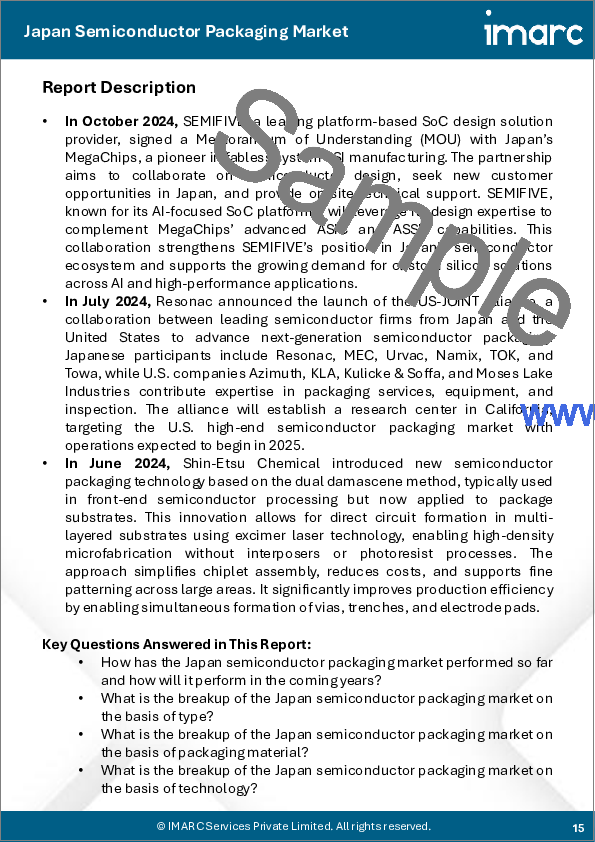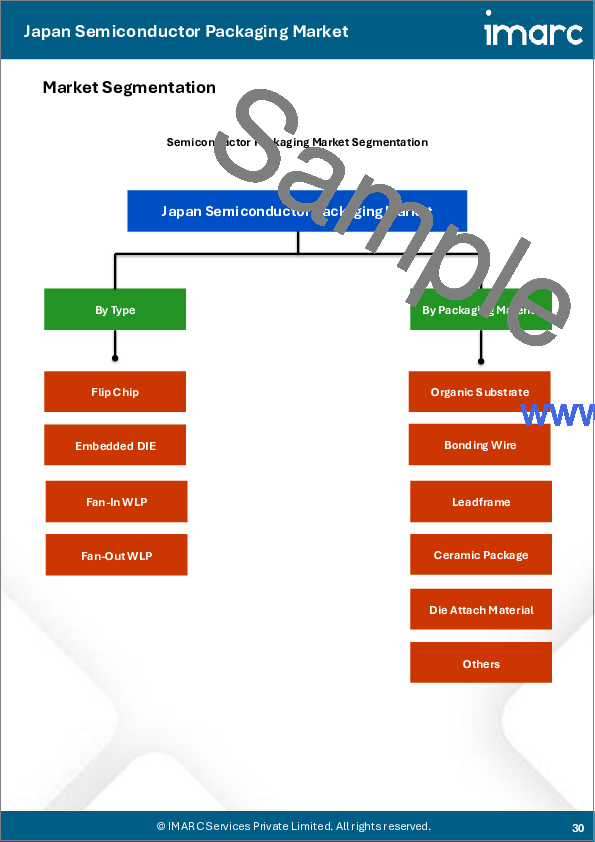|
|
市場調査レポート
商品コード
1747106
日本の半導体パッケージ市場規模、シェア、動向、予測:タイプ、包装材料、テクノロジー、エンドユーザー、地域別、2025年~2033年Japan Semiconductor Packaging Market Size, Share, Trends and Forecast by Type, Packaging Material, Technology, End User, and Region, 2025-2033 |
||||||
カスタマイズ可能
|
|||||||
| 日本の半導体パッケージ市場規模、シェア、動向、予測:タイプ、包装材料、テクノロジー、エンドユーザー、地域別、2025年~2033年 |
|
出版日: 2025年06月02日
発行: IMARC
ページ情報: 英文 121 Pages
納期: 5~7営業日
|
全表示
- 概要
- 目次
日本の半導体パッケージ市場規模は2024年に22億1,779万米ドルに達しました。今後、IMARC Groupは、同市場が2033年までに40億2,616万米ドルに達し、2025年から2033年にかけて6.85%の成長率(CAGR)を示すと予測しています。同市場は、小型で高性能なコンシューマーエレクトロニクスに対する需要の高まり、カーエレクトロニクスの進歩、AIや5G技術の導入拡大が牽引しています。国産チップ生産に対する政府の支援や地元メーカーによる強力な研究開発投資も、技術競争力とサプライチェーンの強靭性を確保し、成長に寄与しています。
本レポートで扱う主な質問
- 日本の半導体パッケージ市場はこれまでどのように推移し、今後どのように推移するのか?
- 日本の半導体パッケージ市場のタイプ別区分は?
- 日本の半導体パッケージ市場の包装材別の区分は?
- 日本の半導体パッケージ市場のテクノロジー別の区分は?
- 日本の半導体パッケージ市場のエンドユーザー別の区分は?
- 日本の半導体パッケージ市場のバリューチェーンにおける様々なステージとは?
- 日本の半導体パッケージ市場の主な促進要因と課題は?
- 日本の半導体パッケージ市場の構造と主要企業は?
- 日本の半導体パッケージ市場の競合状況は?
目次
第1章 序文
第2章 調査範囲と調査手法
- 調査の目的
- ステークホルダー
- データソース
- 市場推定
- 調査手法
第3章 エグゼクティブサマリー
第4章 日本の半導体パッケージ市場-イントロダクション
- 概要
- 市場力学
- 業界動向
- 競合情報
第5章 日本の半導体パッケージ市場情勢
- 過去および現在の市場動向(2019~2024年)
- 市場予測(2025~2033年)
第6章 日本の半導体パッケージ市場- タイプ別の内訳
- フリップチップ
- 組み込みDIE
- ファンインWLP
- ファンアウトWLP
第7章 日本の半導体パッケージ市場- 包装材料別の内訳
- 有機基質
- ボンディングワイヤ
- リードフレーム
- セラミックパッケージ
- ダイアタッチ材
- その他
第8章 日本の半導体パッケージ市場- テクノロジー別の内訳
- グリッド配列
- スモールアウトラインパッケージ
- フラットリードなしパッケージ
- デュアルインラインパッケージ
- その他
第9章 日本の半導体パッケージ市場- エンドユーザー別内訳
- 家電
- 自動車
- ヘルスケア
- IT・通信
- 航空宇宙・防衛
- その他
第10章 日本の半導体パッケージ市場-競合情勢
- 概要
- 市場構造
- 市場企業のポジショニング
- 主要成功戦略
- 競合ダッシュボード
- 企業評価象限
第11章 主要企業のプロファイル
第12章 日本の半導体パッケージ市場- 業界分析
- 促進要因・抑制要因・機会
- ポーターのファイブフォース分析
- バリューチェーン分析
第13章 付録
The Japan semiconductor packaging market size reached USD 2,217.79 Million in 2024. Looking forward, IMARC Group expects the market to reach USD 4,026.16 Million by 2033, exhibiting a growth rate (CAGR) of 6.85% during 2025-2033. The market is driven by rising demand for compact, high-performance consumer electronics, advancements in automotive electronics, and increased deployment of AI and 5G technologies. Government support for domestic chip production and strong R&D investments by local manufacturers also contribute to growth, ensuring technological competitiveness and supply chain resilience.
Japan Semiconductor Packaging Market Trends:
Integration of Advanced Automotive Electronics
Japan's prominence in automotive innovation is significantly influencing its semiconductor packaging landscape. As electric vehicles (EVs), autonomous systems, and connected car technologies become more sophisticated, demand is rising for robust semiconductor packages that can withstand high thermal loads and complex functionality. Japanese automakers are increasingly incorporating advanced driver-assistance systems (ADAS), power modules, and in-vehicle infotainment-each requiring compact and high-reliability semiconductor packaging. This shift is pushing packaging providers to develop heat-resistant and space-efficient solutions, such as multi-chip modules and system-in-package (SiP) configurations. Collaborations between semiconductor firms and automotive OEMs have accelerated, focusing on vertical integration and co-development of packaging technologies tailored to vehicular environments. The convergence of automotive and semiconductor sectors is thus reshaping packaging priorities, with emphasis on longevity, precision, and miniaturization. For instance, in December 2024, TOPPAN Inc. announced its participation in the US-JOINT consortium, a U.S.-Japan initiative led by Resonac Corporation to develop next-generation semiconductor packaging technologies. TOPPAN will contribute as a packaging substrate manufacturer, supporting advancements in 2.5D and 3D packaging for applications like AI and autonomous driving.
Rise of Glass Core Substrates in High-Density Packaging
Japan is witnessing growing interest in the adoption of glass core substrates for high-density semiconductor packaging, particularly for applications in data centers, AI chips, and high-performance computing. Glass substrates offer superior dimensional stability, better electrical insulation, and flatter surfaces compared to traditional organic materials, enabling more precise layering and interconnect density. Japanese companies are investing in refining the fabrication processes for glass-based substrates to enhance yield and integration capability. This trend aligns with global shifts toward chiplet architectures, where multiple smaller chips are integrated on a single substrate to function as a unified system. Japanese firms, known for their material science expertise, are uniquely positioned to lead innovations in this domain, helping meet performance, space, and power efficiency requirements of emerging computing platforms. For instance, in June 2024, Rapidus Corporation and IBM announced an expanded partnership focused on developing chiplet packaging technologies for 2nm-generation semiconductors. Building on an existing 2nm node collaboration, the initiative is part of a NEDO-backed Japanese project to advance next-gen semiconductor packaging. The goal is to establish Japan as a key player in advanced chiplet packaging, supporting AI and HPC applications and strengthening the global semiconductor supply chain.
Japan Semiconductor Packaging Market Segmentation:
Type Insights:
- Flip Chip
- Embedded DIE
- Fan-In WLP
- Fan-Out WLP
Packaging Material Insights:
- Organic Substrate
- Bonding Wire
- Leadframe
- Ceramic Package
- Die Attach Material
- Others
Technology Insights:
- Grid Array
- Small Outline Package
- Flat no-leads Package
- Dual In-Line Package
- Others
End User Insights:
- Consumer Electronics
- Automotive
- Healthcare
- IT and Telecommunication
- Aerospace and Defense
- Others
Competitive Landscape:
The market research report has also provided a comprehensive analysis of the competitive landscape. Competitive analysis such as market structure, key player positioning, top winning strategies, competitive dashboard, and company evaluation quadrant has been covered in the report. Also, detailed profiles of all major companies have been provided.
Key Questions Answered in This Report:
- How has the Japan semiconductor packaging market performed so far and how will it perform in the coming years?
- What is the breakup of the Japan semiconductor packaging market on the basis of type?
- What is the breakup of the Japan semiconductor packaging market on the basis of packaging material?
- What is the breakup of the Japan semiconductor packaging market on the basis of technology?
- What is the breakup of the Japan semiconductor packaging market on the basis of end user?
- What are the various stages in the value chain of the Japan semiconductor packaging market?
- What are the key driving factors and challenges in the Japan semiconductor packaging market?
- What is the structure of the Japan semiconductor packaging market and who are the key players?
- What is the degree of competition in the Japan semiconductor packaging market?
Table of Contents
1 Preface
2 Scope and Methodology
- 2.1 Objectives of the Study
- 2.2 Stakeholders
- 2.3 Data Sources
- 2.3.1 Primary Sources
- 2.3.2 Secondary Sources
- 2.4 Market Estimation
- 2.4.1 Bottom-Up Approach
- 2.4.2 Top-Down Approach
- 2.5 Forecasting Methodology
3 Executive Summary
4 Japan Semiconductor Packaging Market - Introduction
- 4.1 Overview
- 4.2 Market Dynamics
- 4.3 Industry Trends
- 4.4 Competitive Intelligence
5 Japan Semiconductor Packaging Market Landscape
- 5.1 Historical and Current Market Trends (2019-2024)
- 5.2 Market Forecast (2025-2033)
6 Japan Semiconductor Packaging Market - Breakup by Type
- 6.1 Flip Chip
- 6.1.1 Overview
- 6.1.2 Historical and Current Market Trends (2019-2024)
- 6.1.3 Market Forecast (2025-2033)
- 6.2 Embedded DIE
- 6.2.1 Overview
- 6.2.2 Historical and Current Market Trends (2019-2024)
- 6.2.3 Market Forecast (2025-2033)
- 6.3 Fan-in WLP
- 6.3.1 Overview
- 6.3.2 Historical and Current Market Trends (2019-2024)
- 6.3.3 Market Forecast (2025-2033)
- 6.4 Fan-out WLP
- 6.4.1 Overview
- 6.4.2 Historical and Current Market Trends (2019-2024)
- 6.4.3 Market Forecast (2025-2033)
7 Japan Semiconductor Packaging Market - Breakup by Packaging Material
- 7.1 Organic Substrate
- 7.1.1 Overview
- 7.1.2 Historical and Current Market Trends (2019-2024)
- 7.1.3 Market Forecast (2025-2033)
- 7.2 Bonding Wire
- 7.2.1 Overview
- 7.2.2 Historical and Current Market Trends (2019-2024)
- 7.2.3 Market Forecast (2025-2033)
- 7.3 Leadframe
- 7.3.1 Overview
- 7.3.2 Historical and Current Market Trends (2019-2024)
- 7.3.3 Market Forecast (2025-2033)
- 7.4 Ceramic Package
- 7.4.1 Overview
- 7.4.2 Historical and Current Market Trends (2019-2024)
- 7.4.3 Market Forecast (2025-2033)
- 7.5 Die Attach Material
- 7.5.1 Overview
- 7.5.2 Historical and Current Market Trends (2019-2024)
- 7.5.3 Market Forecast (2025-2033)
- 7.6 Others
- 7.6.1 Historical and Current Market Trends (2019-2024)
- 7.6.2 Market Forecast (2025-2033)
8 Japan Semiconductor Packaging Market - Breakup by Technology
- 8.1 Grid Array
- 8.1.1 Overview
- 8.1.2 Historical and Current Market Trends (2019-2024)
- 8.1.3 Market Forecast (2025-2033)
- 8.2 Small Outline Package
- 8.2.1 Overview
- 8.2.2 Historical and Current Market Trends (2019-2024)
- 8.2.3 Market Forecast (2025-2033)
- 8.3 Flat no-leads Package
- 8.3.1 Overview
- 8.3.2 Historical and Current Market Trends (2019-2024)
- 8.3.3 Market Forecast (2025-2033)
- 8.4 Dual In-Line Package
- 8.4.1 Overview
- 8.4.2 Historical and Current Market Trends (2019-2024)
- 8.4.3 Market Forecast (2025-2033)
- 8.5 Others
- 8.5.1 Historical and Current Market Trends (2019-2024)
- 8.5.2 Market Forecast (2025-2033)
9 Japan Semiconductor Packaging Market - Breakup by End User
- 9.1 Consumer Electronics
- 9.1.1 Overview
- 9.1.2 Historical and Current Market Trends (2019-2024)
- 9.1.3 Market Forecast (2025-2033)
- 9.2 Automotive
- 9.2.1 Overview
- 9.2.2 Historical and Current Market Trends (2019-2024)
- 9.2.3 Market Forecast (2025-2033)
- 9.3 Healthcare
- 9.3.1 Overview
- 9.3.2 Historical and Current Market Trends (2019-2024)
- 9.3.3 Market Forecast (2025-2033)
- 9.4 IT and Telecommunication
- 9.4.1 Overview
- 9.4.2 Historical and Current Market Trends (2019-2024)
- 9.4.3 Market Forecast (2025-2033)
- 9.5 Aerospace and Defense
- 9.5.1 Overview
- 9.5.2 Historical and Current Market Trends (2019-2024)
- 9.5.3 Market Forecast (2025-2033)
- 9.6 Others
- 9.6.1 Historical and Current Market Trends (2019-2024)
- 9.6.2 Market Forecast (2025-2033)
10 Japan Semiconductor Packaging Market - Competitive Landscape
- 10.1 Overview
- 10.2 Market Structure
- 10.3 Market Player Positioning
- 10.4 Top Winning Strategies
- 10.5 Competitive Dashboard
- 10.6 Company Evaluation Quadrant
11 Profiles of Key Players
- 11.1 Company A
- 11.1.1 Business Overview
- 11.1.2 Products Offered
- 11.1.3 Business Strategies
- 11.1.4 SWOT Analysis
- 11.1.5 Major News and Events
- 11.2 Company B
- 11.2.1 Business Overview
- 11.2.2 Products Offered
- 11.2.3 Business Strategies
- 11.2.4 SWOT Analysis
- 11.2.5 Major News and Events
- 11.3 Company C
- 11.3.1 Business Overview
- 11.3.2 Products Offered
- 11.3.3 Business Strategies
- 11.3.4 SWOT Analysis
- 11.3.5 Major News and Events
- 11.4 Company D
- 11.4.1 Business Overview
- 11.4.2 Products Offered
- 11.4.3 Business Strategies
- 11.4.4 SWOT Analysis
- 11.4.5 Major News and Events
- 11.5 Company E
- 11.5.1 Business Overview
- 11.5.2 Products Offered
- 11.5.3 Business Strategies
- 11.5.4 SWOT Analysis
- 11.5.5 Major News and Events
12 Japan Semiconductor Packaging Market - Industry Analysis
- 12.1 Drivers, Restraints, and Opportunities
- 12.1.1 Overview
- 12.1.2 Drivers
- 12.1.3 Restraints
- 12.1.4 Opportunities
- 12.2 Porters Five Forces Analysis
- 12.2.1 Overview
- 12.2.2 Bargaining Power of Buyers
- 12.2.3 Bargaining Power of Suppliers
- 12.2.4 Degree of Competition
- 12.2.5 Threat of New Entrants
- 12.2.6 Threat of Substitutes
- 12.3 Value Chain Analysis





